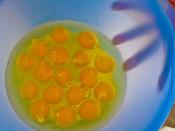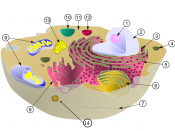Both plant and animal cells are developed to carry out the functions of their organism. Both of these cells have extreme similarities and differences. There are also two basic types of cells, prokaryote, which are cells that lack an internal structure and are surrounded by membranes. These are usually one-celled organisms. The second kind is eukaryote; which are cells containing internal, membrane bound structures. These structures are called organelles, and they will also be the topic of this essay.
The animal cell's 'control center' is the nucleus. It is the largest of the organelles and contains the cell's DNA and controls the cell's functions. The nucleus is surrounded by a nuclear envelope. It is a double membrane and each membrane is two layers, so it results in being four layers thick. The function of the nuclear envelope is to pass materials back and forth between the nucleus and the rest of the cell through its pores, known as the nuclear pores.
These nuclear pores are necessary for RNA to pass through for protein synthesis. The DNA in the nucleus forms long strands of chromatin and when they are condensed, they form chromosomes. Also contained in the nucleus is the nucleolus, which produces the cell particles that are involved in protein synthesis. The cell particles that are produced are called ribosomes. They are the part of the cell that creates enzymes and other proteins, according to the DNA. The ribosomes are still considered organelles, even though they are not surrounded by a membrane.
Surrounding the nucleus and other organelles is cytoplasm. It is a clear liquid, which is enclosed by the plasma membrane, and is where many chemical reactions, such as protein synthesis, take place. Cytoplasm takes up a little more than half the volume of an animal cell. The...


